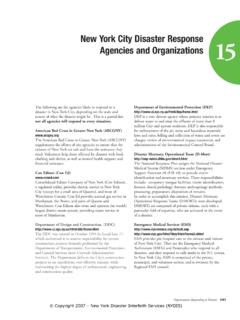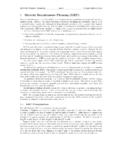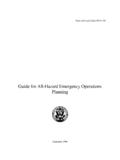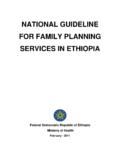Transcription of Disaster Response Planning & Preparedness: 1
1 Editor s Note: This Chapter is thecontinuation of an adaptation of a state plan for Disaster preparation and Response . In total, the original chapter comprisesChapters 1, 14, OverviewMany of you are reading this manual aspart of your efforts to prepare as a spiritualcare professional who will be ready torespond during times of Disaster . Your mainrole will be to provide emotional andspiritual support to those affected bydisaster, but it is also critical for you tounderstand the context in which you willbe providing this support the biggerpicture, so to relief operations are complexsystems having more to them than just aresponse mechanism. They require asignificant amount of experts have long known thatwaiting until a Disaster strikes to test acommunity s Response procedures can bedisastrous. How communities respond todisaster can even induce more stress onindividuals and place them at risk fordeveloping a variety of adverse reactionsand psychological consequences.
2 Thissection takes the first step towardsintroducing you to the key elements ofdisaster management and Response atmultiple focus of this chapter is on theframework of Disaster Planning , preparedness , and Response . In the event ofa Disaster in your community, you may beasked and/or may want to help. It will helpyou to have an understanding of thestructure of the overall Response so that youknow how your efforts will enhance theoverall operation that makes disasterresponse ManagementContinuum1 All Disaster Response begins at the local leveland as such, communities must be preparedfor whatever happens, no matter how big orsmall. Health care systems play an integralrole in a community s Disaster Response ;therefore, these systems must also beprepared to meet the tremendous challengesthat are brought forth by disasters andpublic health emergencies.
3 Successfuldisaster Response requires a community andits health care system to: Define and anticipate Disaster risks andhazards; Prepare the material resources and skilledpersonnel to respond to these risks andhazards; Develop comprehensive plans to deploythese resources to assist the communityand its recovery; Learn from disasters and translate thelessons learned into invaluable of Disaster111 Disaster Response Planning & Preparedness: PHASES OF DISASTERBY JACK HERRMANNJack Herrmann is of Psychiatry atthe University of RochesterSchool of Medicine andDentistry and Director ofthe Program in DisasterMental Health in theDepartment of Psychiatryand the UR Center forDisaster Medicine andEmergency over a decade, he hasresponded to numerousnational disasters as avolunteer with theAmerican Red also developedcomprehensive disastermental health trainingprograms for the New YorkState Office of MentalHealth and the New YorkState Department ofHealth currently beingdisseminated throughoutevery county, statepsychiatric center andacute healthcare facilitythroughout New YorkState.
4 Copyright 2007 New York Disaster Interfaith Services (NYDIS) Disaster management is the preparation for, Response to, and recovery from there are different understandings ofDisaster Management, it is generally viewedas a cycle with the following five key phases: Planning and preparedness Phase Mitigation Phase Response Phase Recovery Phase Evaluation PhaseEach phase presents opportunities fordisaster mental health and spiritual careprofessionals to be involved. Each of thephases below, while written from acommunity perspective, can and should betranslated into a perspective that includesthe needs of a house of worship as andPreparedness PhaseThe Planning and preparedness Phaseisdesigned to structure the Disaster responseprior to the occurrence of a Disaster . It is astate of readiness to respond to a Disaster orother emergency situation and involvesevaluating the community s potential disasterrisks, vulnerabilities, and the likelihood for adisaster to occur.
5 This risk assessment processis sometimes referred to as an All-HazardsAnalysis2. An All-Hazards Analysis can becompleted at multiple levels, including: Federal, state, and county levels Hospital, business and agency levels Personal and family levelsDepending on the Disaster , there are someincidents that may present more risk andchallenge than others for hospitals. Forexample, a small house fire may presentminimal risk for both a community and ahospital if they have the resources toadequately respond to the needs of theindividuals involved. A large structural fire,such as a 23 floor office building withmultiple people killed or sufferingsignificant burn injuries, may presentsignificant challenges for both thecommunity and the health care system, nomatter how large the city or how manyresources they have at hand.
6 Communitiesand houses of worships systems must assessthe risk of such scenarios above and Planning and preparedness phase alsoassesses the community s or house ofworship s systems infrastructure ( ,availability of backup communications,transportation options, economic viability,etc.) and its capability to respond to thepotential risks and vulnerabilities identifiedin the All-Hazards Analysis. Assessingavailable mental health and spiritual carepersonnel and training them in disasterresponse is an example of a Planning andPreparedness of Disaster12 Disaster expertshave long knownthat waiting until adisaster strikes totest a community sresponseprocedures can bedisastrous. Copyright 2007 New York Disaster Interfaith Services (NYDIS)It is important to note, however, thathaving the best plan or the mostexperienced team will not always guaranteea successful Disaster Response .
7 There aresome disasters whose magnitude and/orunique characteristics will stress even themost prepared system or team. In thesecases, individual and system flexibility isimperative. Developing a plan and responseteam that is flexible and able to adapt towhatever occurs is extremely important. Inmany cases, peoples lives will depend on the scenario where an entirehospital is rendered inoperable as a result ofa flood or decontaminated by a biologicalor chemical agent. A plan and responseteam that had only considered the provisionof services from their usual site will quicklybecome overwhelmed with how to respondwhen their site suddenly does not PhaseThe Mitigation Phase, also known as thePrevention Phase, is characterized by themeasures taken to reduce the harmfuleffects of a Disaster in order to limit itsimpact on human health, communityfunction, and economic this phase, steps are taken toprepare acommunity or house of worshipfor Disaster , especially high-risk locations( hospitals in areas that typically flood)and populations.
8 There is supportingresearch that suggests individuals,communities, and hospitals are moreresilient following Disaster when they haveanticipated and prepared for disasteroutcomes. For example, having a personalor family Disaster plan can be a step towardsmitigating the effects of Disaster when itstrikes a particular family. Ensuring that allpersonnel understand their roles in disasterresponse and are educated on theappropriate evacuation plan for a particularindividual, family, agency, department, ororganization, and other Response activitiescan achieve similar positive PhaseThe Response Phaseis the actualimplementation of the Disaster Response is the organization ofactivities used to respond to the event andits aftermath. The Response Phase focusesprimarily on emergency relief: saving lives,providing first aid, minimizing andrestoring damaged systems(communications and transportation),meeting the basic life requirements of thoseimpacted by Disaster (food, water, andshelter), and providing mental health andspiritual support and comfort care.
9 Recovery PhaseThe Recovery Phasefocuses on thestabilization and return of the communityand health care system to its pre-impactstatus or what some describe as gettingback to normal. Activities of the RecoveryPhase can range from rebuilding damagedbuildings and repairing a community sinfrastructure to relocating populations andinstituting intermediate and long-termmental health interventions. The RecoveryPhase can begin days, or in some cases,months after Disaster strikes. In theaftermath of catastrophic disasters such asHurricane Katrina, the concept of returninga community or healthcare system to itspre-impact status might seem unlikely orimpossible. In these cases, the recoveryefforts focus on helping communities andsystems adapt to a new sense of normal. Phases of Disaster13 Disaster Response isthe organization ofactivities used torespond to theevent and itsaftermath.
10 Copyright 2007 New York Disaster Interfaith Services (NYDIS)Evaluation PhaseThe Evaluation Phaseof the disastermanagement continuum often receives theleast amount of attention. A timely andthoughtful evaluation process is essential indetermining what worked versus what didnot, so that future revisions andenhancements to the Disaster plan andresponse system can be made. Communitiesor health care systems that fail toimplement an evaluation phase in thecontext of their Disaster managementprocess find they are no better prepared thenext time Disaster you can see, each phase presents uniqueopportunities for communities, hospitals,and individuals to focus on how they willprepare for, respond to, and recover fromdisaster before the event actually to Disaster : Who Gets Involved, How,When, and Why?The Local ResponseAll disasters start at the local level3.











